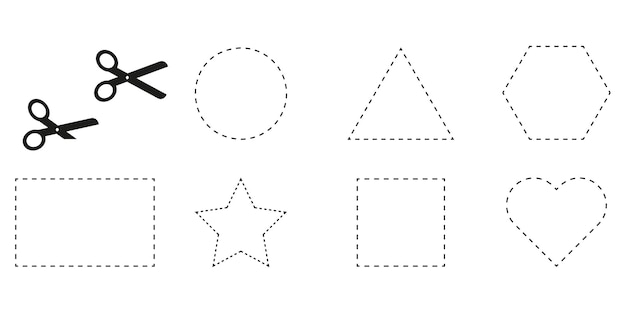
1. The Importance of Scissor Skills
Before diving into the world of scissor skills worksheets, let’s understand why these skills are so crucial for a child’s development. Scissor skills are a part of fine motor skills, which involve the use of small muscles in the hands and fingers. These skills are essential for various daily activities, including buttoning shirts, tying shoelaces, and, most notably, writing.
2. What Are Scissor Skills Haircut Worksheets?
Scissor skills haircut worksheets are educational materials designed to help children improve their scissor skills through engaging activities. These worksheets often feature images of haircuts, animals, or objects that kids can cut out along the lines, resembling a hairstylist’s job.
3. Why Are Scissor Skills Haircut Worksheets Beneficial?
These worksheets offer a plethora of advantages:
- Fine Motor Development: Cutting along lines on worksheets strengthens the muscles in a child’s hand, enhancing their fine motor skills.
- Hand-Eye Coordination: Kids must coordinate their hand movements with their visual perception to cut accurately.
- Creativity: Cutting out various shapes and designs encourages creativity and imagination.
- Preparation for School: Developing scissor skills provides a head start for tasks involving writing and drawing.
- Focus and Patience: Completing intricate cuts requires concentration and patience, teaching valuable life skills.
4. How to Introduce Scissor Skills Worksheets
To begin, choose age-appropriate worksheets and provide child-safe scissors. Demonstrate the cutting process, emphasizing the correct hand position and motion. Encourage your child to follow along, starting with simple straight lines.
5. Choosing the Right Worksheets
Select worksheets that match your child’s skill level. Beginners should start with basic shapes and straight lines, while more advanced learners can tackle complex designs. There are countless free and paid worksheets available online to cater to all stages of development.
6. Fun Activities to Enhance Scissor Skills
Make learning enjoyable by turning it into a game. Challenge your child to cut out shapes as accurately as possible or create a story using the cutout pieces. This adds an element of fun to the learning process.
7. Progressive Challenges for Mastery
As your child’s skills improve, gradually introduce worksheets with more intricate patterns and curved lines. This progressive approach keeps them engaged and motivated.
8. Patience and Guidance: Key Elements
Remember that mastering scissor skills takes time. Be patient and offer guidance when needed. Celebrate your child’s achievements, no matter how small, to boost their confidence.
9. Safety First: Supervising Scissor Activities
Always supervise scissor activities, especially with younger children. Ensure they use child-safe scissors and sit in a comfortable, well-lit area.
10. Incorporating Scissor Skills into Daily Life
Encourage your child to use their scissor skills in daily life. They can help cut out coupons, trim paper, or even assist with simple cooking tasks under close supervision.
11. The Connection Between Scissor Skills and Handwriting
Strong scissor skills lay the foundation for good handwriting. The hand muscles and hand-eye coordination developed through cutting activities directly benefit the formation of letters and shapes in writing.
12. Success Stories: How Scissor Skills Worksheets Have Helped
Many parents and educators have witnessed remarkable progress in children’s fine motor skills and creativity through the consistent use of scissor skills haircut worksheets. Children often become more confident and independent as they master this essential skill.
13. Frequently Asked Questions (FAQs)
Q1. At what age can I start introducing scissor skills worksheets to my child?
A1. You can begin introducing scissor skills worksheets around the age of 3 to 4, but always consider your child’s readiness and motor skills.
Q2. How can I make sure my child uses scissors safely?
A2. Ensure your child uses child-friendly scissors, provide supervision, and teach them safe handling techniques.
Q3. Are there left-handed scissors for children?
A3. Yes, left-handed scissors are available to make cutting easier for left-handed children.
Q4. Can scissor skills worksheets benefit children with special needs?
A4. Yes, these worksheets can be adapted to suit children with various abilities and needs.
Q5. How long does it take for a child to master scissor skills?
A5. The time it takes varies, but with regular practice and guidance, most children can master basic scissor skills within a few months.
14. Conclusion
Scissor skills haircut worksheets are more than just fun activities; they are powerful tools for enhancing a child’s fine motor skills, creativity, and preparation for writing. With the right worksheets, guidance, and a dash of creativity, your child can embark on a journey of skill development that will benefit them throughout their lives.




